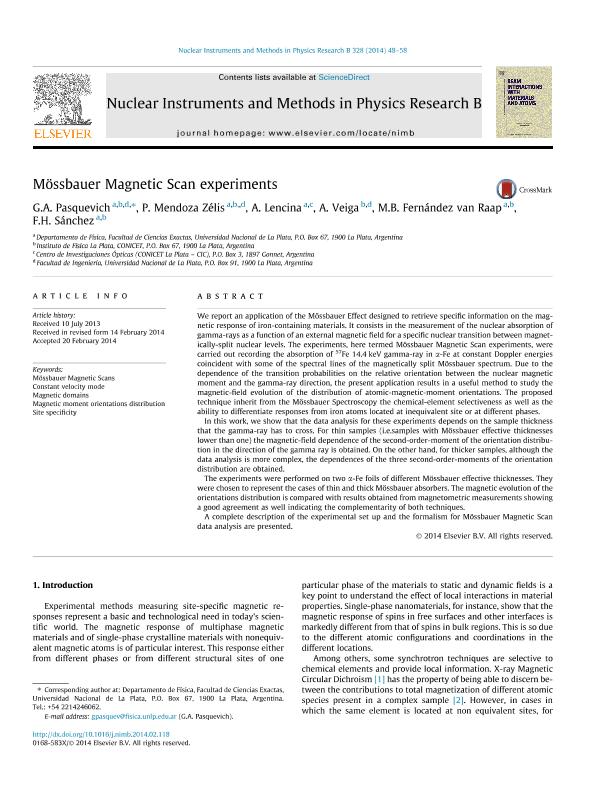Mostrar el registro sencillo del ítem
dc.contributor.author
Pasquevich, Gustavo Alberto

dc.contributor.author
Mendoza Zélis, Pedro

dc.contributor.author
Lencina, Alberto Germán

dc.contributor.author
Veiga, Alejandro Luis

dc.contributor.author
Fernandez Van Raap, Marcela Beatriz

dc.contributor.author
Sanchez, Francisco Homero

dc.date.available
2017-01-26T20:24:01Z
dc.date.issued
2014-06
dc.identifier.citation
Pasquevich, Gustavo Alberto; Mendoza Zélis, Pedro; Lencina, Alberto Germán; Veiga, Alejandro Luis; Fernandez Van Raap, Marcela Beatriz; et al.; Mössbauer Magnetic Scan experiments; Elsevier Science; Nuclear Instruments and Methods in Physics Research B: Beam Interactions with Materials and Atoms; 328; 6-2014; 48-58
dc.identifier.issn
0168-583X
dc.identifier.uri
http://hdl.handle.net/11336/12027
dc.description.abstract
We report an application of the Mössbauer Effect designed to retrieve specific information on the magnetic response of iron-containing materials. It consists in the measurement of the nuclear absorption of gamma-rays as a function of an external magnetic field for a specific nuclear transition between magnetically-split nuclear levels. The experiments, here termed Mössbauer Magnetic Scan experiments, were carried out recording the absorption of 57Fe 14.4 keV gamma-ray in a-Fe at constant Doppler energies coincident with some of the spectral lines of the magnetically split Mössbauer spectrum. Due to the dependence of the transition probabilities on the relative orientation between the nuclear magnetic moment and the gamma-ray direction, the present application results in a useful method to study the magnetic-field evolution of the distribution of atomic-magnetic-moment orientations. The proposed technique inherit from the Mössbauer Spectroscopy the chemical-element selectiveness as well as the ability to differentiate responses from iron atoms located at inequivalent site or at different phases. In this work, we show that the data analysis for these experiments depends on the sample thickness that the gamma-ray has to cross. For thin samples (i.e.samples with Mössbauer effective thicknesses lower than one) the magnetic-field dependence of the second-order-moment of the orientation distribution in the direction of the gamma ray is obtained. On the other hand, for thicker samples, although the data analysis is more complex, the dependences of the three second-order-moments of the orientation distribution are obtained. The experiments were performed on two a-Fe foils of different Mössbauer effective thicknesses. They were chosen to represent the cases of thin and thick Mössbauer absorbers. The magnetic evolution of the orientations distribution is compared with results obtained from magnetometric measurements showing a good agreement as well indicating the complementarity of both techniques. A complete description of the experimental set up and the formalism for Mössbauer Magnetic Scan data analysis are presented.
dc.format
application/pdf
dc.language.iso
eng
dc.publisher
Elsevier Science

dc.rights
info:eu-repo/semantics/openAccess
dc.rights.uri
https://creativecommons.org/licenses/by-nc-nd/2.5/ar/
dc.subject
Instrumentation
dc.subject
Mossbauer Magnetic Scan
dc.subject
Moments Orientation Distribution
dc.subject
Constant Doppler Velocity
dc.subject.classification
Física de los Materiales Condensados

dc.subject.classification
Ciencias Físicas

dc.subject.classification
CIENCIAS NATURALES Y EXACTAS

dc.title
Mössbauer Magnetic Scan experiments
dc.type
info:eu-repo/semantics/article
dc.type
info:ar-repo/semantics/artículo
dc.type
info:eu-repo/semantics/publishedVersion
dc.date.updated
2017-01-24T18:31:27Z
dc.journal.volume
328
dc.journal.pagination
48-58
dc.journal.pais
Países Bajos

dc.journal.ciudad
Amsterdam
dc.description.fil
Fil: Pasquevich, Gustavo Alberto. Universidad Nacional de la Plata. Facultad de Ciencias Exactas. Departamento de Física; Argentina. Consejo Nacional de Investigaciones Científicas y Técnicas. Centro Científico Tecnológico La Plata. Instituto de Física La Plata; Argentina. Universidad Nacional de La Plata. Facultad de Ingenieria; Argentina
dc.description.fil
Fil: Mendoza Zélis, Pedro. Universidad Nacional de la Plata. Facultad de Ciencias Exactas. Departamento de Física; Argentina. Consejo Nacional de Investigaciones Científicas y Técnicas. Centro Científico Tecnológico La Plata. Instituto de Física La Plata; Argentina. Universidad Nacional de La Plata. Facultad de Ingenieria; Argentina
dc.description.fil
Fil: Lencina, Alberto Germán. Universidad Nacional de la Plata. Facultad de Ciencias Exactas. Departamento de Física; Argentina. Consejo Nacional de Investigaciones Científicas y Técnicas. Centro Científico Tecnológico La Plata. Centro de Investigaciones Opticas (i); Argentina. Provincia de Buenos Aires. Gobernación. Comisión de Investigaciones Científicas; Argentina
dc.description.fil
Fil: Veiga, Alejandro Luis. Consejo Nacional de Investigaciones Científicas y Técnicas. Centro Científico Tecnológico La Plata. Instituto de Física La Plata; Argentina. Universidad Nacional de La Plata. Facultad de Ingenieria; Argentina
dc.description.fil
Fil: Fernandez Van Raap, Marcela Beatriz. Universidad Nacional de la Plata. Facultad de Ciencias Exactas. Departamento de Física; Argentina. Consejo Nacional de Investigaciones Científicas y Técnicas. Centro Científico Tecnológico La Plata. Instituto de Física La Plata; Argentina
dc.description.fil
Fil: Sanchez, Francisco Homero. Universidad Nacional de la Plata. Facultad de Ciencias Exactas. Departamento de Física; Argentina. Consejo Nacional de Investigaciones Científicas y Técnicas. Centro Científico Tecnológico La Plata. Instituto de Física La Plata; Argentina
dc.journal.title
Nuclear Instruments and Methods in Physics Research B: Beam Interactions with Materials and Atoms

dc.relation.alternativeid
info:eu-repo/semantics/altIdentifier/doi/http://dx.doi.org/10.1016/j.nimb.2014.02.118
dc.relation.alternativeid
info:eu-repo/semantics/altIdentifier/url/http://www.sciencedirect.com/science/article/pii/S0168583X14003759
Archivos asociados
